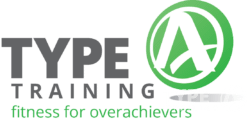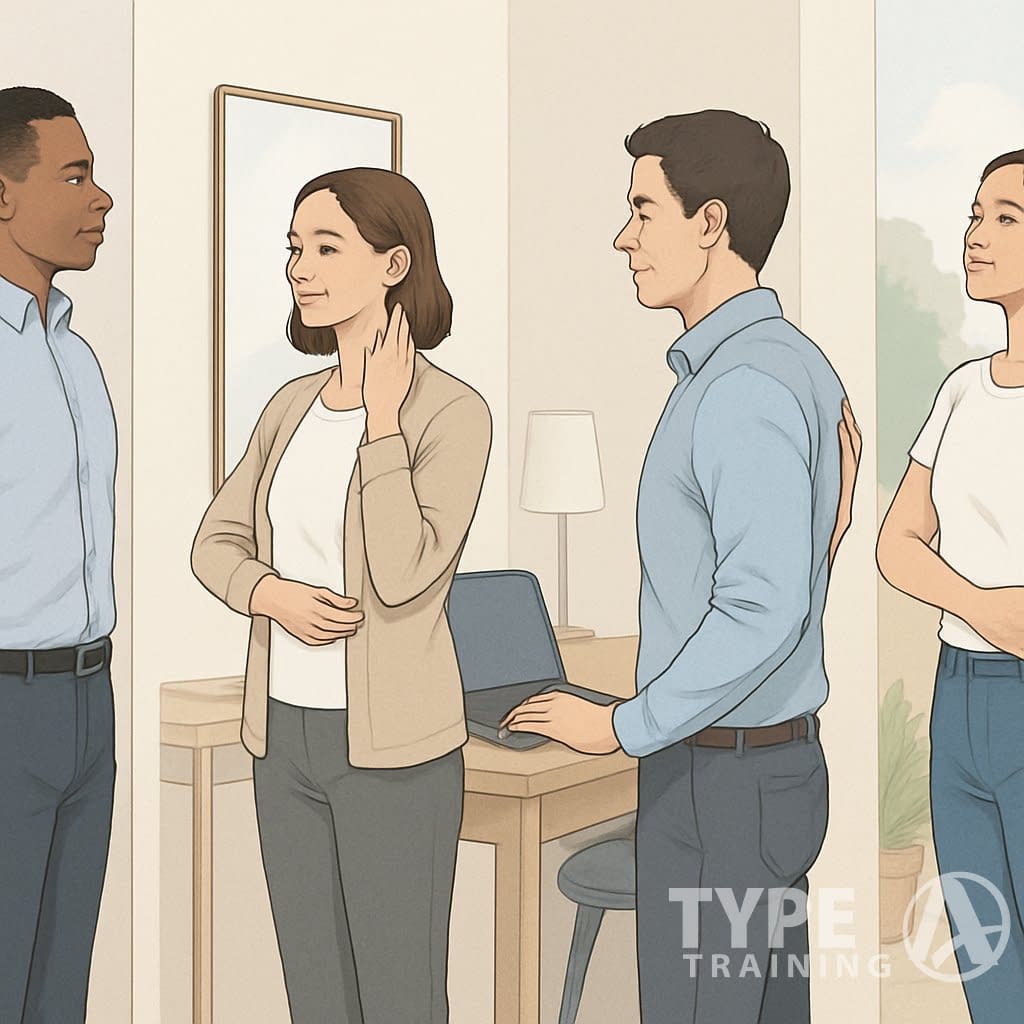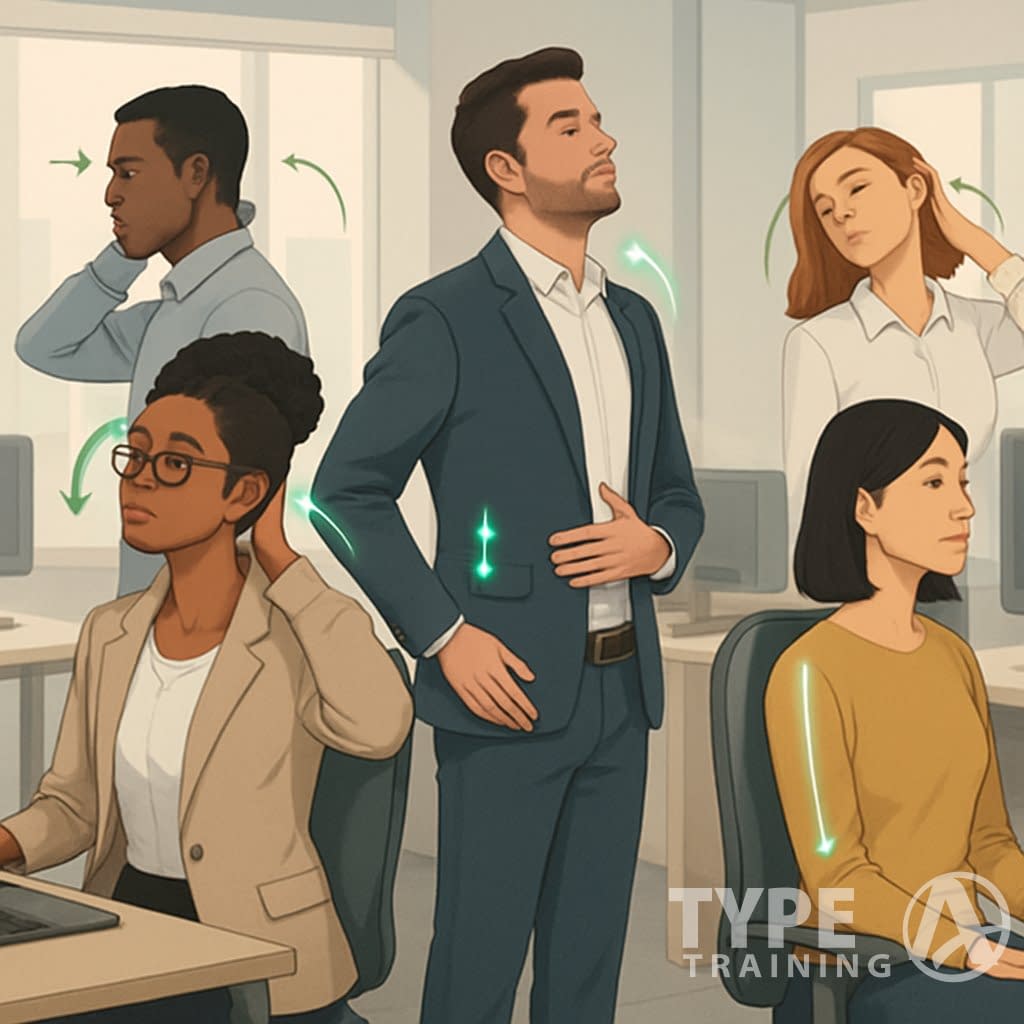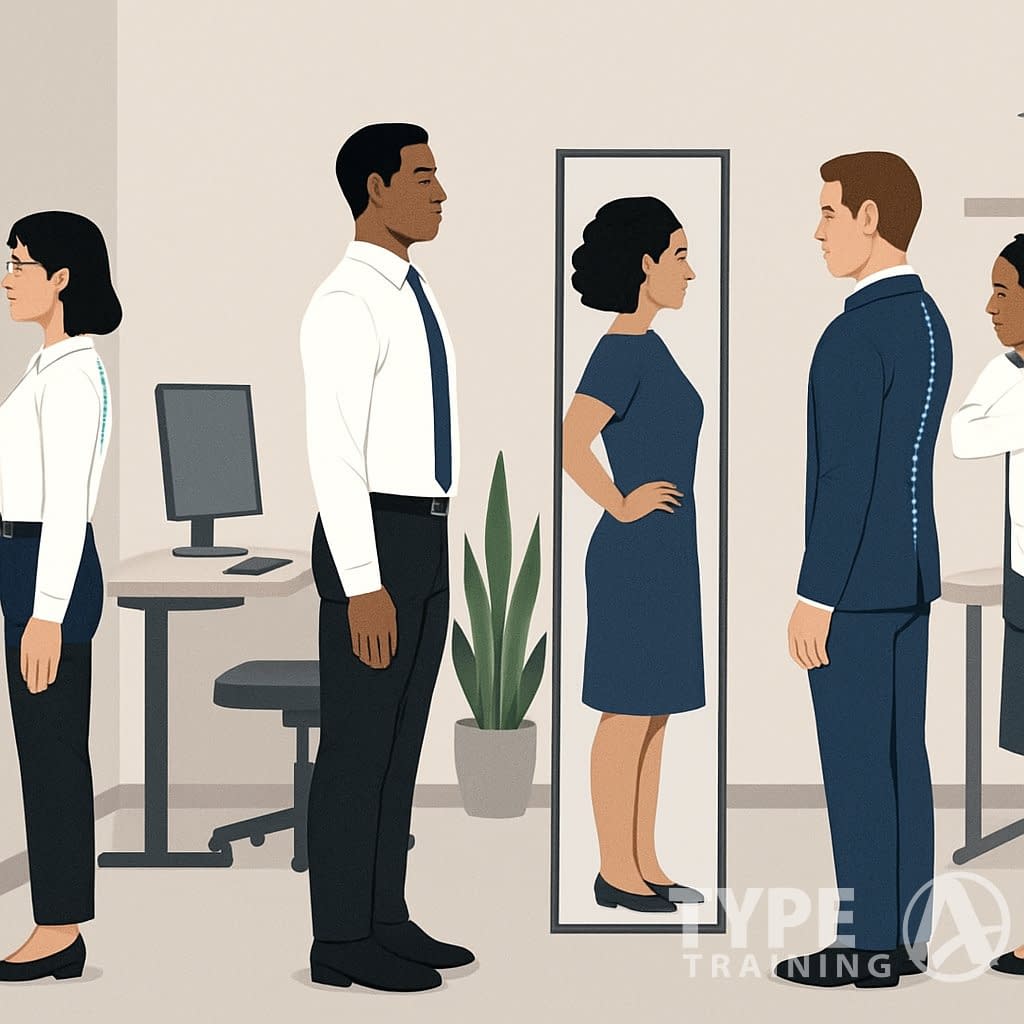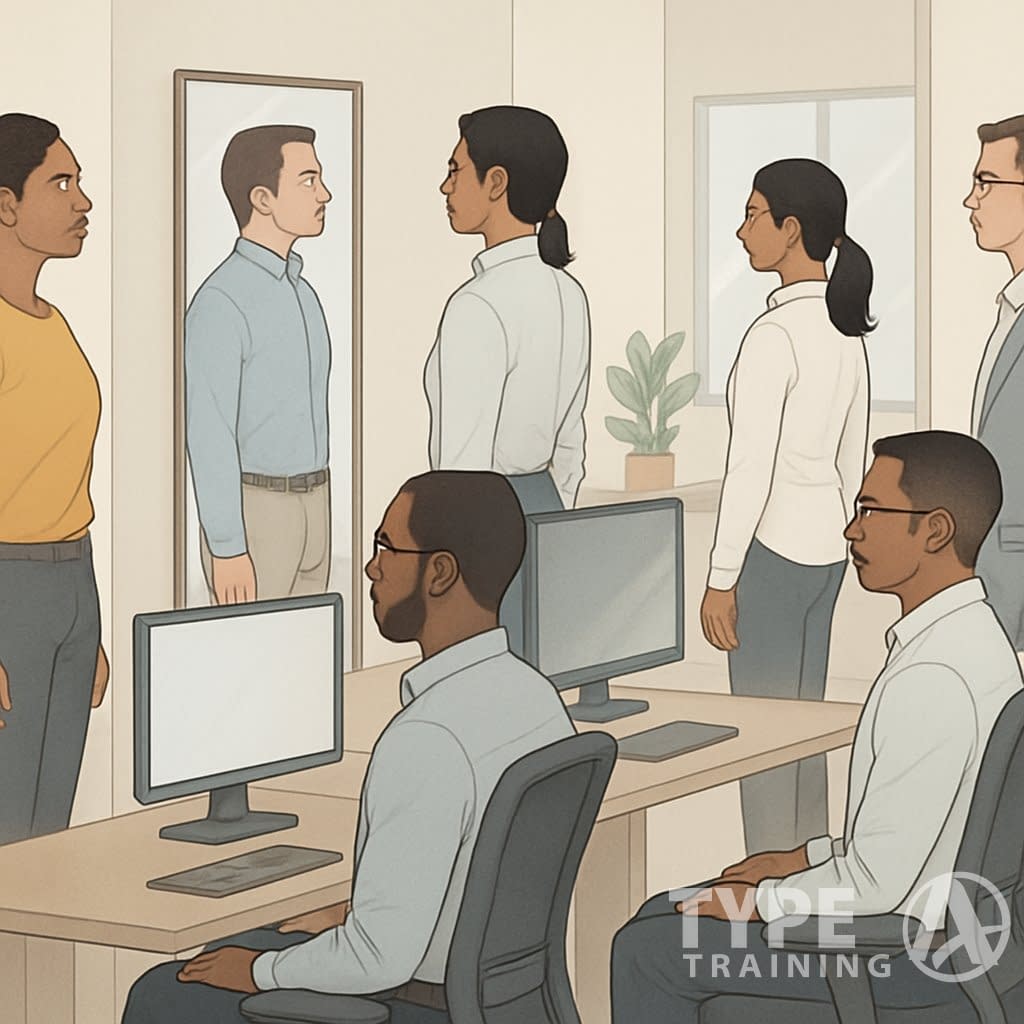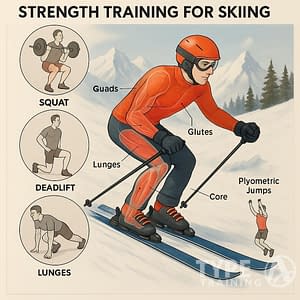Long hours at a desk, constant phone checking, and rushed meetings—sounds familiar, right? All these habits set you up for poor posture.
Conducting a posture self-assessment is crucial for long-term health.
As a busy professional, maybe you notice shoulder tension, neck pain, or back stiffness. Still, finding time for drawn-out posture evaluations or pricey assessments? Not likely.
Fitting in a quick posture self-assessment can be easier than you think.
Popular posts:
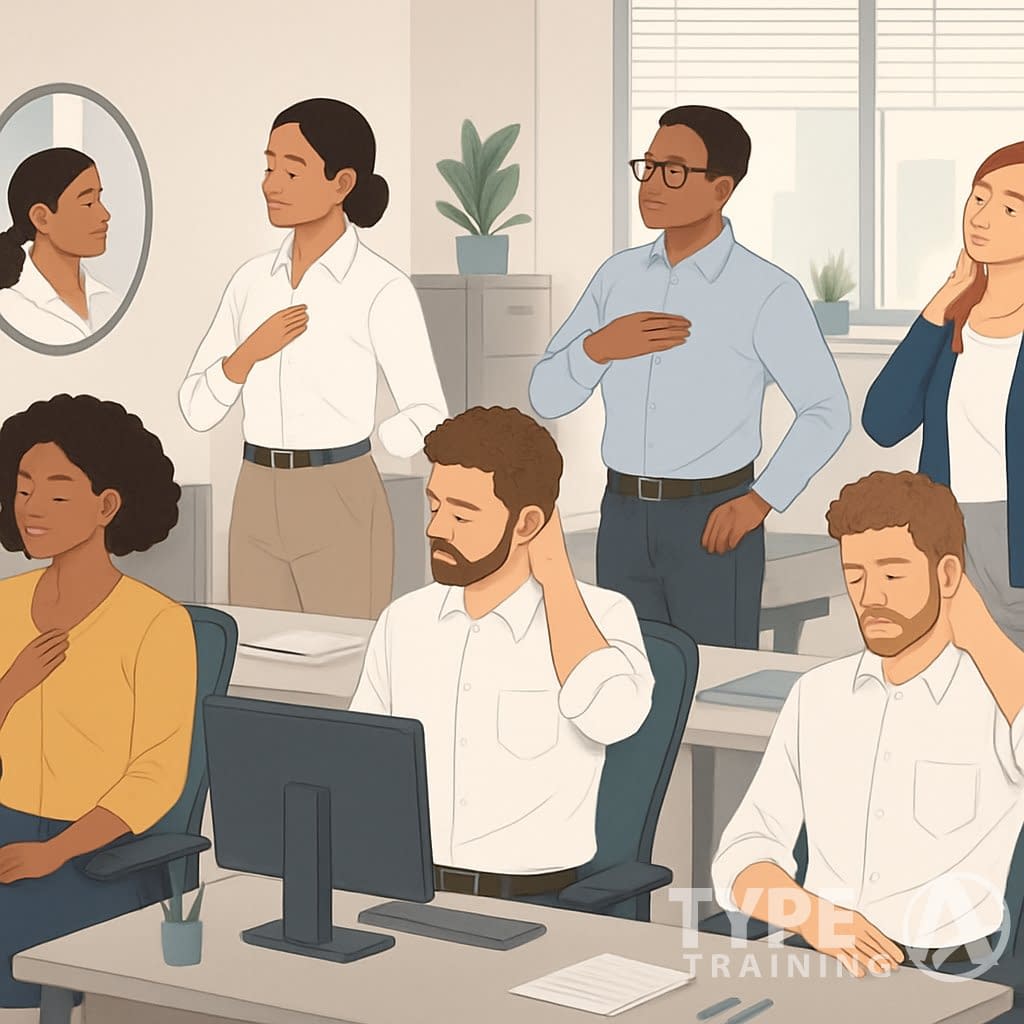
You can check your posture in under five minutes with just a wall, your phone camera, and a little body awareness. These quick self-assessment tricks help you spot classic posture problems—forward head, rounded shoulders, pelvic misalignment—the usual suspects for office workers.
For a thorough posture self-assessment, observe your alignment throughout the day.
You can do these tests anywhere: at your desk, at home, even in a hotel room if you’re traveling. Knowing where your posture needs help is the first step to easing pain and feeling more confident.
A simple posture self-assessment can reveal areas needing attention.
Key Takeaways
- Desk work often leads to neck pain, shoulder tension, and back problems that can mess with your performance.
- Wall tests and phone camera checks can reveal big posture issues in just a few minutes.
- Quick daily corrections and awareness habits help prevent long-term problems and ease discomfort.
Why Posture Matters for Busy Professionals
Regular posture self-assessment will lead to improved well-being.
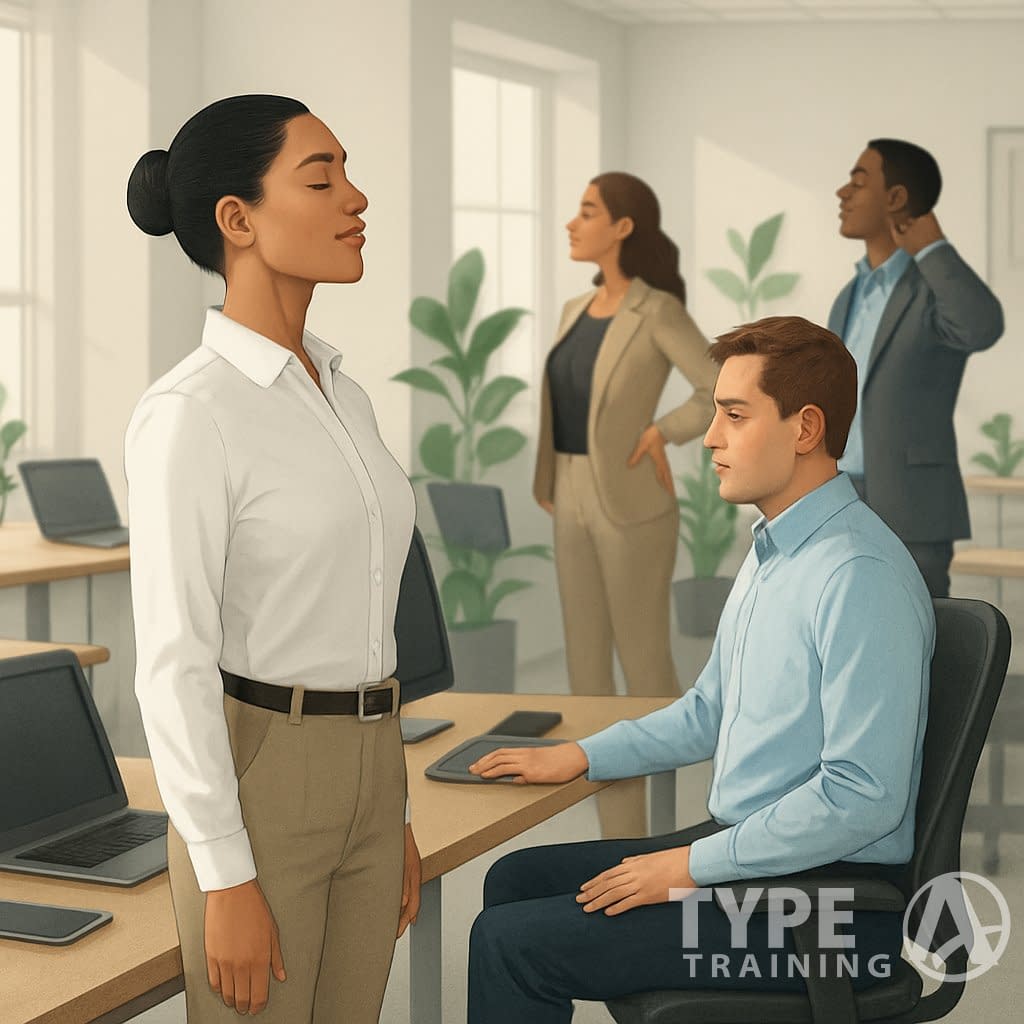
Poor posture can seriously mess with your health and work performance. Good posture, on the other hand, boosts energy, confidence, and productivity.
Performing a posture self-assessment can enhance your productivity at work.
Impact of Poor Posture on Health
A quick posture self-assessment could save you from chronic pain.
Poor posture puts extra stress on your muscles, joints, and spine. Slouching or leaning forward forces your body to work overtime just to keep you upright.
Consider scheduling a regular posture self-assessment to maintain your health.
Back pain is the big one. If you sit wrong for hours, your spine curves in ways it shouldn’t, leading to muscle strain and joint pressure.
Other health issues pop up too:
- Neck and shoulder pain from the head jutting forward
- Headaches caused by tight neck muscles
- Reduced lung capacity because your chest gets compressed
- Poor blood flow from cramped positions
- Digestive problems from squished organs
Over time, some muscles get too tight, others too loose. This imbalance makes it harder to keep good posture without thinking about it.
Implementing a daily posture self-assessment as part of your routine is beneficial.
Bad posture drains your energy too. When your spine’s out of whack, your body spends more effort just keeping you upright.
Benefits of Good Posture in the Workplace
Good posture lets your body do its job. Muscles, joints, and organs all work better when things line up.
More energy is a big perk. If you sit straight, your lungs open up and you breathe easier. Blood flows better too.
Less pain, less fatigue. Aligning your body means less strain on your back, neck, and shoulders.
People notice good posture:
- You look more confident and professional
- Stronger presence in meetings
- You seem more alert
- Focus and concentration improve
If you’re not distracted by pain, you get more done. Thinking feels easier when your body’s not yelling at you.
Good posture also reduces your risk of chronic back pain, joint issues, and muscle imbalances.
Common Causes of Bad Posture in Professionals
Modern work setups aren’t doing us any favors. Most professionals spend over eight hours a day in positions that mess with posture.
Desk setup is usually to blame. Maybe your monitor’s too low, your chair lacks support, or your keyboard’s just out of reach.
Common mistakes:
- Slouching in the chair
- Forward head from staring at screens
- Rounded shoulders from reaching for the keyboard
- Crossed legs that mess with your hips
- Leaning to one side over and over
Long sitting stints weaken your postural muscles. Hip flexors tighten up, glutes get lazy, and your core just checks out.
Stress makes it worse. When you’re tense, you hunch your shoulders and clench your neck.
Outside work, bad habits pile on. Looking down at your phone, carrying bags on one shoulder, or sleeping in weird positions all add up.
Simple Self-Assessment Tests You Can Do Anywhere
A quick posture self-assessment can be performed using just a few simple tools.
Try these three tests—no fancy equipment, no expert needed. The wall test checks your standing posture alignment, the mirror test shows visual imbalances, and flexibility tests call out tight muscles.
Utilizing a posture self-assessment can help identify any misalignments.
The Wall Test for Standing Alignment
Stand with your back against a flat wall. Heels should be 2–4 inches from the wall, feet about shoulder-width.
Let your body settle naturally. The back of your head, shoulder blades, and buttocks should all touch the wall.
Now, check the gaps behind your neck and lower back. Slide your hand into those spaces. You should fit one hand flat in each spot.
Here’s what the gaps mean:
- Big gap at your neck = forward head posture
- Large gap at lower back = swayback
- No gap at lower back = flat back
If your head can’t touch the wall without effort, you’ve probably got forward head posture. That’s super common for anyone glued to a computer.
The whole thing takes 30 seconds and gives you instant feedback.
The Mirror Test for Front and Side View
Implementing a frequent posture self-assessment routine can enhance your posture.
Face a full-length mirror and stand how you usually do. Check these from the front:
-
- Head straight, not tilted
Incorporate a quick posture self-assessment into your break times.
- Shoulders level
- Hips even
- Kneecaps pointing forward
If one shoulder sits higher, maybe you always carry a bag on that side. Uneven hips could mean muscle imbalances.
A posture self-assessment can be a game changer for your daily routine.
For the side view, snap a photo or have someone else do it. Imagine a line from your ear down to your ankle.
That line should pass through your shoulder, middle of your torso, behind your hip, and in front of your knee. If your ear’s way forward of your shoulder, that’s forward head posture.
The mirror test shows imbalances you might not feel but can definitely see.
The Flexibility and Range of Motion Check
Engaging in a posture self-assessment helps reveal tight muscles.
A lot of posture problems come from tight muscles. Try these quick checks:
Shoulder blade squeeze: Pull your shoulder blades together and hold for five seconds. If it feels super tight or you can’t bring them close, your chest muscles are probably tight from hunching.
Upper back rotation: Sit and twist your upper body left and right. You should get about 45 degrees each way. If not, your upper back might be stiff.
Hip flexor test: Step one foot forward into a lunge. Push your back hip forward gently. If the front of your back hip feels tight, those hip flexors are probably shortened from too much sitting.
All of this takes about two minutes. Tight muscles pull your body out of alignment and cause the issues you see in the wall and mirror tests.
Do these flexibility checks every week to catch tightness before it turns into pain.
Analyzing Your Results: Identifying Posture Issues
A proper posture self-assessment can help in identifying your body’s needs.
Once you’ve finished your quick posture tests, it’s time to figure out what your body’s telling you. Look for anything that strays from a neutral spine, and pay attention to how your upper body, shoulder blades, and lower back work together.
Recognizing Signs of Good and Poor Posture
Using a posture self-assessment can significantly improve your comfort levels.
Good posture forms a straight line from your ear to your ankle if you look from the side. Your head sits right over your shoulders, not pushed forward.
Shoulders should be level and relaxed, not hunched. Your spine keeps its natural curves—no excessive rounding or arching.
When you stand against a wall, your head, upper back, and butt should touch easily.
Poor posture stands out. Maybe your head juts forward, straining your neck. One shoulder’s higher, or both roll forward.
Your back might round too much, or your pelvis could tilt too far forward or back. These misalignments cause muscle imbalances that lead to pain and fatigue.
Watch for these warning signs:
Each time you do a posture self-assessment, you learn more about your body.
- Head more than two inches from the wall in the wall test
- Shoulders don’t touch the wall naturally
- Big gap or no gap at all at your lower back
- Uneven shoulders from behind
Understanding Upper Back and Shoulder Blade Alignment
Your upper back should curve gently, not form a hump. If it rounds too much, it pulls your shoulders forward and makes you look hunched.
Frequent posture self-assessment can help keep your alignment in check.
Shoulder blades should rest flat against your back, about 3–4 inches apart. They shouldn’t wing out or pinch together. When they’re in the right spot, your shoulders sit over your ribcage.
Forward head posture often comes with upper back rounding. This combo stresses your neck muscles and can trigger headaches.
Upper back problems might look like:
- A visible hump between your shoulder blades
- Shoulder blades sticking out
- Shoulders rolling forward past your chest
- Struggling to touch the wall with your head during the wall test
Healthy alignment means:
- Shoulder blades move freely but rest flat
- Shoulders stack over hips from the side
- Neck keeps its natural curve
Spotting Lower Back Curve Irregularities
Your lower back should have a gentle inward curve (lordosis). This helps spread out weight and absorb impact.
Too much curve makes your butt stick out—classic swayback. Your pelvis tips forward, pressuring your lower back.
Not enough curve flattens your lower back, often paired with rounded shoulders. This kills shock absorption and risks disc issues.
Lower back red flags:
-
- More than a hand’s width between your back and the wall
Regular posture self-assessment will ensure you stay aware of your body.
-
- No space at all between your lower back and wall
- Back pain when standing for a while
Using a posture self-assessment can help alleviate posture-related discomfort.
- Can’t keep the curve without effort
A normal curve means:
- 2–4 inches of space between your back and the wall
- Standing feels comfortable, not painful
- Easy to go from sitting to standing
- Walking feels smooth, not jarring
Quick Interventions for a Straighter Posture
Small tweaks to your workspace and daily habits can actually improve your posture pretty fast. It’s all about setting up your environment to support you and throwing in a few simple moves to undo the damage from sitting.
Desk and Workstation Adjustments
Set your monitor at eye level or just below. That way, you won’t tilt your head forward and strain your neck.
Keep your monitor about 20–26 inches from your face. If you’re squinting, bump up the font size instead of leaning in.
Desk setup basics:
- Feet flat on the floor, knees at 90 degrees
- Back against the chair with lumbar support
- Elbows at 90 degrees when typing
- Wrists straight—not bent up or down
Your keyboard and mouse should sit at elbow height. If your desk’s too high, consider a keyboard tray.
Put stuff you use a lot within easy reach. Don’t twist your spine to grab your phone or papers. If you reference documents, use a holder next to your monitor to avoid neck strain.
Standing and Sitting Tips
For better standing posture:
- Distribute your weight evenly on both feet.
- Gently engage your core muscles.
Pull your shoulder blades down and back. Picture a string pulling the crown of your head upward.
When you sit, scoot your hips all the way back in the chair. Let your lower back keep its natural curve against the backrest.
Making posture self-assessment a habit can lead to lasting improvements.
Change positions every 30 minutes. Try setting a phone reminder so you remember to check your posture during the day.
Quick posture reset:
Consider a quick posture self-assessment a part of your daily routine.
- Roll your shoulders up, back, and down.
- Tuck your chin slightly back.
- Lift the top of your head and lengthen your spine.
Avoid crossing your legs for too long. That habit can mess with your blood flow and throw your hips out of balance, which ends up affecting your whole posture.
Routine Stretches and Movements
Neck stretch: Gently tilt your head to each side for 15 seconds. This helps ease tension, especially if your head tends to jut forward.
Doorway chest stretch: Place your forearm on a doorframe and step forward. Hold for 30 seconds on each side to open up your chest muscles.
Cat-cow stretch: Get on your hands and knees, then slowly arch and round your back. This wakes up your spine and can ease back pain.
Shoulder blade squeezes: Pull your shoulder blades together and hold for five seconds. Repeat ten times every few hours.
Hip flexor stretch: Step into a lunge and push your hips forward. This stretch helps undo the tightness from sitting too much.
Incorporating a posture self-assessment can rejuvenate your day.
Try to fit these movements in two or three times a day. Even 30 seconds of stretching can bring quick relief and improve how you stand.
Building Lifelong Habits for Perfect Posture
If you want real change, you’ll need consistent daily actions and some smart tweaks to your environment. Making good posture automatic takes a mix of habit, lifestyle adjustments, and solid sleep support.
Lifestyle Changes for Lasting Results
Committing to a posture self-assessment will provide ongoing benefits.
Building better posture habits isn’t exactly instant. Studies say it takes anywhere from three weeks to a couple of months to lock in a new habit.
Start simple with hourly posture checks. Set a reminder on your phone every hour while you work. When it buzzes, take a second to reset your position.
Add some physical cues around you:
- Stick a note on your monitor.
- Adjust your car mirrors so you have to sit tall to see.
- Change your phone wallpaper to a posture cue.
Strengthen your support muscles with quick daily exercises. Focus on your core, upper back, and glutes. Even five minutes a day is worth it.
Tweak your workspace so it helps, not hurts. Keep your monitor at eye level. Bring your keyboard and mouse close. Use a document holder if you read papers often.
Try the “reset” trick: Slouch on purpose, then sit up super straight, and finally settle into the comfy middle. It’s a good way to figure out what actually feels right.
Importance of Mattress and Sleep Position
Your mattress and pillow matter for your posture—think about it, you spend a third of your life there. Bad sleep positioning can undo all your daytime effort.
Pick a mattress with the right firmness. Most people do best with medium-firm. Too soft? You’ll sink. Too hard? Pressure points.
Your pillow height should match how you sleep:
- Back sleepers: Go for a medium pillow that supports your neck curve.
- Side sleepers: Use a thick, firm pillow to fill the gap from ear to shoulder.
- Stomach sleepers: Use a thin pillow or skip it (though honestly, this position isn’t great for your neck or back).
If you sleep on your side, put a pillow between your knees. That helps keep your hips aligned and can cut down on back pain.
Try not to sleep on your stomach. It twists your neck and flattens your lower back, which can make things worse.
Maintaining Motivation for Good Posture
A consistent posture self-assessment can improve your overall health.
Staying motivated is tricky. Tracking progress and celebrating small wins really helps.
Keep a posture journal for a month. Each day, rate your posture awareness from 1 to 10. Jot down any back pain or energy shifts.
Take monthly photos doing the wall test. Compare them over time. Seeing progress—however small—can be surprisingly motivating.
Focus on how good posture feels:
- Easier breathing and more energy
- Fewer headaches
- Less back pain
- A boost in confidence
Get an accountability buddy. Ask a coworker or family member to nudge you about posture now and then. Make it a shared effort.
Reward yourself when you hit milestones. Maybe a treat after a week of hourly checks, or something fun after a month.
Remember, perfect posture isn’t about being stiff. It’s about finding a comfortable, balanced position that you can actually stick with.
For the complete posture training system, check out The Ultimate Guide to Posture Training for Busy Professionals.
Frequently Asked Questions
Keep a record of your posture self-assessment to monitor improvements.
Millions of professionals deal with poor posture every day. It leads to neck pain, back strain, and just feeling drained. Quick self-tests can spot problems fast, and there are plenty of digital tools and exercises that help you stay on track—especially during busy workdays.
What are quick and effective tests to determine if my posture needs improvement?
Try the wall test—it only takes a couple of minutes and gives you instant feedback. Stand with your back against a wall, heels two to four inches from it. Your head, shoulder blades, and butt should all touch the wall naturally.
Slide your hand behind your neck and lower back. You should feel a small gap—about one to two inches. If your head doesn’t touch the wall, you probably have forward head posture.
The mirror test is helpful too. Face a mirror and look for uneven shoulders, a tilted head, or one hip higher. If you spot these, you might have muscle imbalances.
For a side view, have someone snap a picture of you standing naturally. Imagine a line from your ear to your ankle—it should pass through your shoulder, hip, and knee.
Which apps are recommended for monitoring and improving posture for professionals?
PostureScreen Mobile uses photos to analyze your spine and head position. It gives detailed reports and tracks your progress. Office workers who want a pro-level assessment might like it.
Posture Reminder apps send alerts throughout your day. They’re simple but effective—set them to buzz every 30–60 minutes.
Upright Go is a small device you stick on your upper back. It connects to your phone and vibrates if you slouch. It’s especially handy during long meetings or desk work.
Some fitness trackers now offer posture monitoring. Check your current device before downloading new apps—you might already have what you need.
What indicators suggest that I might have poor posture?
Getting headaches a lot? That could be from forward head posture—when your ears creep ahead of your shoulders. It strains your neck and can cause tension headaches. Tech workers know this pain all too well.
Noticing changes in your body through a posture self-assessment is essential.
Rounded shoulders make you look hunched and squeeze your chest. You might notice it’s harder to take deep breaths or you get winded easily.
Lower back pain often comes from too much curve or a flat back. It usually gets worse if you stand for long stretches or when you get up from a chair.
If your clothes fit unevenly—like one pant leg feels tighter, or your jacket sits crooked—muscle imbalances could be to blame.
You might just feel more tired than others by midday. When your muscles work overtime to support poor posture, fatigue builds up fast.
How does body posture impact overall health and professional performance?
Regularly practicing a posture self-assessment can help mitigate issues.
Bad posture squashes your lungs a bit, making it harder to breathe deeply. Less oxygen means more fatigue and foggier thinking—definitely not ideal for work.
Misalignment strains your muscles and leads to chronic pain. It’s tough to focus on your tasks when your neck or shoulders are throbbing.
Slouching can even mess with your digestion by pressing on your stomach. That can mean heartburn or slower metabolism, which zaps your energy.
Poor circulation is another issue—sitting or standing wrong for long stretches can make your legs and feet swell. Not exactly comfortable during a big presentation.
On the bright side, standing tall projects confidence and authority. That’s a real boost during client meetings or networking events.
What are common posture patterns and how can they be corrected?
Forward head posture is everywhere—about 60% of office workers deal with it from staring at screens. Try chin tucks and chest stretches daily. Keep your monitor at eye level to help your neck out.
Rounded shoulders happen from typing or reaching forward all day. Do doorway chest stretches and squeeze your shoulder blades together ten times every hour.
A deep lower back arch usually means your core is weak from too much sitting. Planks and pelvic tilts can help. Use lumbar support if you’re stuck sitting for hours.
If your hips are uneven, you might be carrying a bag on one side or leaning on one leg. Switch sides often and try to stand evenly.
Text neck comes from looking down at your phone. Hold it at eye level and move your neck around every 20 minutes or so.
Can you identify different types of posture and provide tips for maintaining the optimal one?
A posture self-assessment every day will lead to better awareness.
Neutral posture keeps your spine’s natural curves, with your ears over your shoulders and shoulders lined up over your hips. You don’t have to work as hard to stay upright, and your muscles thank you for it.
Try wall stands every day. It’s a simple way to remind your body what “good” feels like.
Kyphosis gives you that hunched look, thanks to an overly curved upper back. Rows and reverse flies help wake up those upper back muscles.
Establishing a routine for posture self-assessment ensures ongoing progress.
Stretch your chest in a doorway a few times a day. It’s quick, and you’ll notice the difference.
Lordosis means your lower back arches too much, usually because your abs aren’t quite pulling their weight. Planks, bridges, and pelvic tilts can help your core catch up.
Skip the high heels if you can—they just make the arch worse.
Flat back syndrome flattens your natural spine curves, so you end up stiff and sometimes sore. Usually, it comes from tucking your pelvis too much.
Hip flexor stretches and gentle back extensions can help. Take it slow and listen to your body.
Set reminders to check your posture every hour or so. Try to keep your head balanced over your spine and engage your core a bit as you move through your day.
Final thoughts: prioritize daily posture self-assessment for lasting health benefits.
